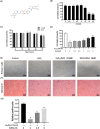Daurisoline attenuates H2O2-induced chondrocyte autophagy by activating the PI3K/Akt/mTOR signaling pathway
- PMID: 36973772
- PMCID: PMC10041752
- DOI: 10.1186/s13018-023-03717-5
Daurisoline attenuates H2O2-induced chondrocyte autophagy by activating the PI3K/Akt/mTOR signaling pathway
Erratum in
-
Correction: Daurisoline attenuates H2O2-induced chondrocyte autophagy by activating the PI3 K/Akt/mTOR signaling pathway.J Orthop Surg Res. 2025 May 16;20(1):471. doi: 10.1186/s13018-025-05845-6. J Orthop Surg Res. 2025. PMID: 40380207 Free PMC article. No abstract available.
Abstract
Background: Osteoarthritis (OA) is a chronic degenerative joint disease characterized by cartilage degeneration and intra-articular inflammation. Daurisoline (DAS) is an isoquinoline alkaloid isolated from Rhizoma Menispermi, whose antitumor and anti-inflammatory pharmacological effects have been demonstrated, but the effects of DAS on OA have rarely been researched. In this study, we aimed to explore the potential role of DAS in OA and its partial mechanism.
Materials and methods: The cytotoxicity of H2O2 and DAS toward chondrocytes was detected by the Cell Counting Kit-8 assay. Safranin O staining was used to detect chondrocyte phenotype changes. Cell apoptosis was measured by both flow cytometry and quantitative analysis of the protein levels of the apoptosis-related factors Bax, Bcl-2 and cleaved caspase-3 by western blot. Western blotting and immunofluorescence were used to assess the expression of the autophagy-related proteins LC3, Beclin-1 and p62. In addition, key signal pathway targets and matrix-degrading indicators were measured by western blot.
Results: Our results indicated that H2O2 induced human chondrocyte apoptosis and activated autophagy in a dose-dependent manner. DAS treatment dose-dependently reversed the expression of apoptosis-related proteins (Bax, Bcl-2 and cleaved caspase3) and the apoptosis rate induced by H2O2. Western blot and immunofluorescence analyses showed that DAS decreased the H2O2-induced upregulation of the autophagy marker Beclin-1 and the LC3 II/LC3 I ratio and upregulated the p62 protein level. Mechanistically, DAS inhibited autophagy through the activation of the classical PI3K/AKT/mTOR signaling pathway and protected chondrocytes from apoptosis. In addition, DAS alleviated the H2O2-induced degradation of type II collagen and the high expression of matrix metalloproteinase 3 (MMP3) and MMP13.
Conclusion: Our research demonstrated that DAS alleviated chondrocyte autophagy caused by H2O2 through activation of the PI3K/AKT/mTOR signaling pathway and protected chondrocytes from apoptosis and matrix degradation. In conclusion, these findings suggest that DAS may serve as a promising therapeutic strategy for OA.
Keywords: Apoptosis; Autophagy; Daurisoline; Osteoarthritis; PI3K/AKT/mTOR signaling pathway.
© 2023. The Author(s).
Conflict of interest statement
The authors declare that they have no known competing financial interests or personal relationships that could have appeared to influence the work reported in this paper.
Figures








Similar articles
-
The Combination Treatment of Curcumin and Probucol Protects Chondrocytes from TNF-α Induced Inflammation by Enhancing Autophagy and Reducing Apoptosis via the PI3K-Akt-mTOR Pathway.Oxid Med Cell Longev. 2021 Jun 24;2021:5558066. doi: 10.1155/2021/5558066. eCollection 2021. Oxid Med Cell Longev. 2021. PMID: 34257809 Free PMC article.
-
Oroxin B alleviates osteoarthritis through anti-inflammation and inhibition of PI3K/AKT/mTOR signaling pathway and enhancement of autophagy.Front Endocrinol (Lausanne). 2022 Dec 1;13:1060721. doi: 10.3389/fendo.2022.1060721. eCollection 2022. Front Endocrinol (Lausanne). 2022. PMID: 36531454 Free PMC article.
-
Baicalin mitigated IL-1β-Induced osteoarthritis chondrocytes damage through activating mitophagy.Chem Biol Drug Des. 2023 Jun;101(6):1322-1334. doi: 10.1111/cbdd.14215. Epub 2023 Mar 5. Chem Biol Drug Des. 2023. PMID: 36752698
-
The PI3K/AKT/mTOR signaling pathway in osteoarthritis: a narrative review.Osteoarthritis Cartilage. 2020 Apr;28(4):400-409. doi: 10.1016/j.joca.2020.02.027. Epub 2020 Feb 18. Osteoarthritis Cartilage. 2020. PMID: 32081707 Review.
-
Metabolic catastrophe as a means to cancer cell death.J Cell Sci. 2007 Feb 1;120(Pt 3):379-83. doi: 10.1242/jcs.03349. J Cell Sci. 2007. PMID: 17251378 Free PMC article. Review.
Cited by
-
Oxidative Stress, MicroRNAs, and Long Non-Coding RNAs in Osteoarthritis Pathogenesis: Cross-Talk and Molecular Mechanisms Involved.Int J Mol Sci. 2025 Jul 3;26(13):6428. doi: 10.3390/ijms26136428. Int J Mol Sci. 2025. PMID: 40650204 Free PMC article. Review.
-
Identification of EGFR as an essential regulator in chondrocytes ferroptosis of osteoarthritis using bioinformatics, in vivo, and in vitro study.Heliyon. 2023 Sep 9;9(9):e19975. doi: 10.1016/j.heliyon.2023.e19975. eCollection 2023 Sep. Heliyon. 2023. PMID: 37810027 Free PMC article.
-
The effect of Miya on skeletal muscle changes by regulating gut microbiota in rats with osteoarthritis through AMPK pathway.BMC Musculoskelet Disord. 2024 Dec 30;25(1):1081. doi: 10.1186/s12891-024-08203-5. BMC Musculoskelet Disord. 2024. PMID: 39736635 Free PMC article.
-
Natural products in osteoarthritis treatment: bridging basic research to clinical applications.Chin Med. 2024 Feb 15;19(1):25. doi: 10.1186/s13020-024-00899-w. Chin Med. 2024. PMID: 38360724 Free PMC article. Review.
-
The emerging role of lncRNAs in osteoarthritis development and potential therapy.Front Genet. 2023 Sep 14;14:1273933. doi: 10.3389/fgene.2023.1273933. eCollection 2023. Front Genet. 2023. PMID: 37779916 Free PMC article. Review.
References
-
- Bortoluzzi A, Furini F, Scirè CA. Osteoarthritis and its management—epidemiology, nutritional aspects and environmental factors. Autoimmun Rev. 2018;17(11):1097–104. - PubMed
-
- Al Faqeh H, Nor Hamdan BM, Chen HC, Aminuddin BS, Ruszymah BH. The potential of intra-articular injection of chondrogenic-induced bone marrow stem cells to retard the progression of osteoarthritis in a sheep model. Exp Gerontol. 2012;47(6):458–64. - PubMed
-
- Burr DB, Gallant MA. Bone remodelling in osteoarthritis. Nat Rev Rheumatol. 2012;8(11):665–73. - PubMed
MeSH terms
Substances
Grants and funding
LinkOut - more resources
Full Text Sources
Medical
Research Materials
Miscellaneous

